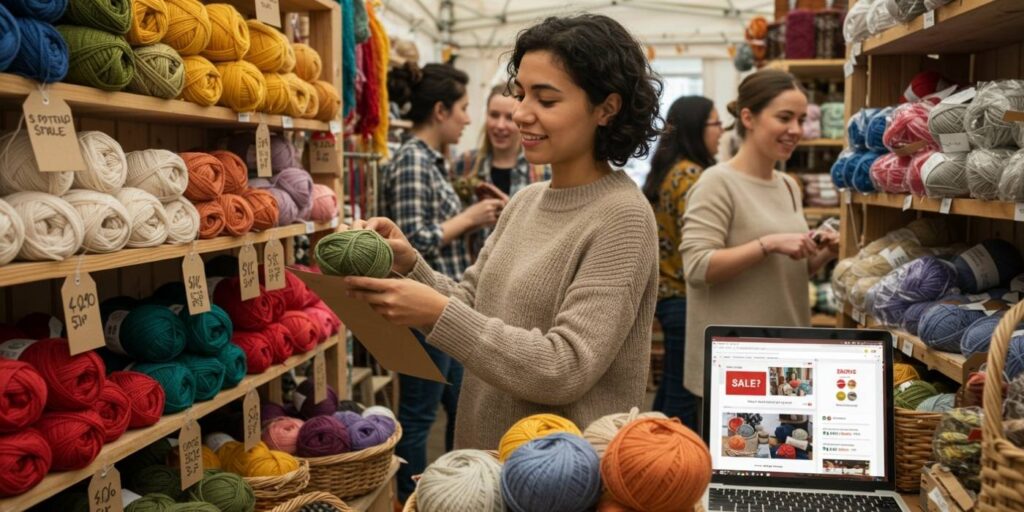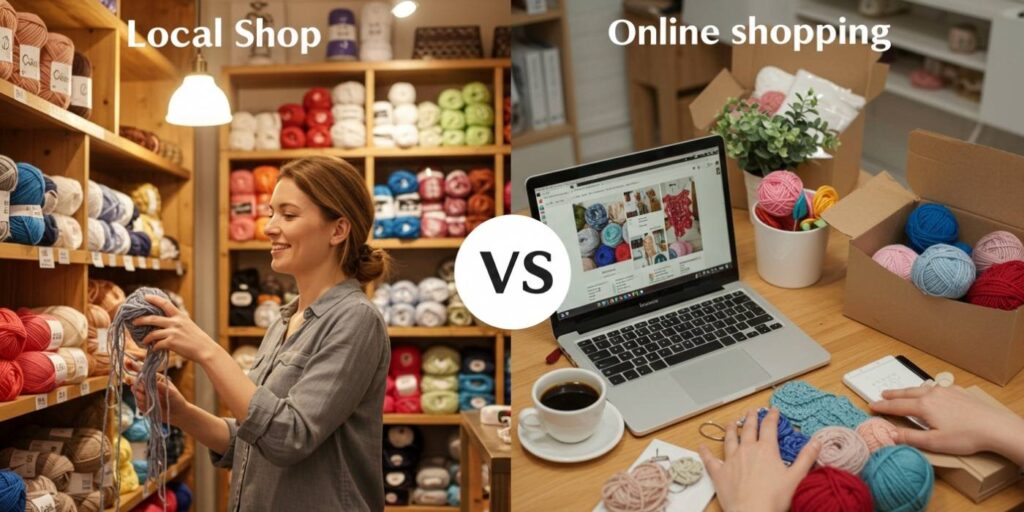Introduction: The Great Yarn Dilemma — Click or Stroll?
Picture this: It’s a rainy Sunday afternoon. You’ve just finished binging your favorite knitting show, and now you’re itching to start a new project. But here’s the million-dollar question — do you grab your laptop and dive into the endless aisles of online yarn shops… or slip on your shoes and head to that cozy little yarn store downtown?
If you’ve ever found yourself torn between these two options, you’re not alone. Whether you’re a seasoned crocheter or a newbie knitter, choosing where to buy your yarn can be just as important as what you’re buying. And honestly? It’s not just about price or color. It’s about experience, convenience, community, and sometimes — surprise shipping fees.
In this article, we’ll break down the real pros and cons of shopping for yarn online versus hitting up your local yarn shop (often lovingly called an LYS). We’ll explore everything from tactile satisfaction to return policies, from instant gratification to global sourcing. By the end, you’ll have a clear, practical roadmap to help you decide which option — or maybe both — best fits your crafting style, budget, and lifestyle.
So grab your favorite cup of tea (or coffee — no judgment here), settle into your comfiest chair, and let’s unravel this yarn-shopping mystery together.
1. The Sensory Experience: Touch, Feel, and Fall in Love
Let’s start with something no screen can truly replicate — touch.
Walking into a local yarn store is like stepping into a fiber wonderland. Soft merino piled high in baskets. Silky bamboo blends draped over wooden shelves. Chunky chenille begging to be squished between your fingers. There’s something deeply satisfying — almost therapeutic — about running your hands through skeins, feeling the weight, the texture, the drape.
Why this matters:
Yarn isn’t just thread — it’s the soul of your project. A scratchy wool might ruin a baby blanket. A too-slippery silk could frustrate a lace shawl. And color? Oh, color! That “heather gray” on your screen might look more like “stormy sidewalk” in real life.
Real-life example:
Sarah, a knitter from Portland, once ordered 10 skeins of “soft sage green” online for a sweater. When they arrived? They were closer to army fatigue. She ended up frogging the whole project — and vowing to never skip swatching in person again.
Online workaround?
Some online shops offer color cards or sample packs. Others have detailed texture descriptions, video swatches, or even live chat with staff. But let’s be real — it’s still not the same as holding it in your hands.
Pro Tip:
If you’re buying online, always check reviews that mention color accuracy and texture. And if possible, order one skein first to test before committing to a whole project.
Bottom line:
Local stores win hands-down for sensory experience. If you’re picky about feel or color, nothing beats an in-person visit.
2. Price, Selection, and the Hunt for Deals

Now, let’s talk turkey — or rather, tension (pun intended).
Online yarn retailers often have massive inventories. Think: hundreds of brands, thousands of colors, global fibers you’ve never even heard of. Plus, thanks to lower overhead costs, many online shops can offer competitive — sometimes jaw-dropping — prices.
The upside of online shopping:
- Bulk discounts: Buying 10+ skeins? Many sites offer automatic discounts.
- Clearance sections: Online shops rotate stock fast, so you’ll often find deep discounts on discontinued lines.
- Global access: Want Icelandic wool? Japanese silk blends? Done. No need to hop on a plane.
But here’s the catch:
Shipping costs. Returns. Duties (if ordering internationally). And let’s not forget — that “bargain” might not feel like one after you’ve paid $12 to ship 3 skeins.
Meanwhile, at your LYS…
Prices might be slightly higher, but you’re paying for curation, expertise, and community. Many local shops offer:
- Loyalty programs (buy 9 skeins, get the 10th free)
- Class bundles (yarn + pattern + instruction)
- Support for indie dyers and small businesses
Real story:
Maria from Austin found a stunning hand-dyed yarn online for $28/skein — but after shipping, taxes, and a surprise “handling fee,” she paid $42. At her LYS, the same dyer’s yarn was $32 — and she got a free stitch marker and 15 minutes of advice from the owner.
Pro Tip:
Use online shops for price comparisons, but don’t forget to factor in total cost. And if you love supporting small businesses, your LYS is a direct investment in your local creative economy.
Bottom line:
Online wins for selection and occasional deep discounts. Local stores offer value through service, loyalty perks, and ethical sourcing — even if the tag price is higher.
3. Instant Gratification vs. The Waiting Game
You know that feeling when inspiration strikes? You’ve got the pattern, the needles, the vision — all you need is the yarn. Right now.
That’s where local stores shine.
Walk in, grab your skeins, pay, and you’re crafting within the hour. No tracking numbers. No “out for delivery” limbo. No porch pirates.
The magic of immediacy:
- Fix mistakes fast (ran out of yarn? Pop back in)
- Get same-day help if you’re unsure about fiber content or gauge
- Avoid project paralysis — start today, not next week
Online? It’s a waiting game.
Even with Prime shipping, you’re looking at 1–3 days minimum. International orders? Could be weeks. And if you forget to check stock levels? You might wait even longer for backorders.
But… online has its own kind of magic:
- Midnight shopping (no closing hours!)
- Wish lists and saved carts for future projects
- Automated restock alerts (so you never miss that limited-edition colorway again)
Real-life hack:
Some crafters use a hybrid approach — keep a “stash emergency kit” at home (basic neutrals, common weights) for spontaneous projects, and order specialty yarns online.
Pro Tip:
If you’re ordering online, always check the estimated delivery date, not just the “ships in 24 hours” note. And sign up for delivery alerts — nothing kills crafting joy like a missed package.
Bottom line:
Need it now? Go local. Planning ahead? Online gives you flexibility — and the joy of surprise packages at your door.
4. Community, Classes, and Human Connection
Here’s something you won’t find in your Amazon cart: belonging.
Local yarn stores are often hubs of creativity and connection. Many host:
- Weekly knit nights
- Beginner classes (crochet, knitting, weaving)
- Charity drives (hats for preemies, blankets for shelters)
- Trunk shows with indie dyers
- Stitch ‘n’ bitch sessions (yes, that’s a real thing — and it’s glorious)
Why community matters:
Crafting can be solitary. But humans? We’re wired for connection. Whether you’re stuck on a tricky stitch or just want to show off your finished shawl, having a “yarn family” makes all the difference.
Online alternatives?
Sure, there are Facebook groups, Ravelry forums, Instagram hashtags (#knittersofinstagram, anyone?), and even Zoom classes. And they’re fantastic! But they lack the warmth of in-person laughter, the shared “oohs” over new arrivals, the impromptu coffee runs with fellow crafters.
Real story:
After moving to a new city, Jen felt isolated — until she wandered into her LYS. Within a month, she’d joined a sock-knitting circle, learned continental knitting from a retired teacher, and even met her now-best friend over a tangled ball of mohair.
Pro Tip:
Even if you mostly shop online, visit your LYS occasionally. Sign up for their newsletter. Follow them on social media. Many now offer hybrid events — in-person + livestream — so you can participate from anywhere.
Bottom line:
If you crave connection, learning, or just a friendly face who knows your yarn preferences by heart — your LYS is irreplaceable. Online communities are great supplements, but they can’t replicate the magic of shared physical space.
5. Returns, Swatches, and the “Oops” Factor

Let’s be honest — we’ve all been there.
You order yarn online. It arrives. You excitedly cast on… only to realize:
- The color is all wrong
- The texture is too rough
- The dye lot doesn’t match
- You bought DK when you needed worsted
Now what?
Online returns:
- Often require you to pay return shipping
- May have time limits (30 days? 14?)
- Some shops won’t accept returns on sale items or custom orders
- Restocking fees? Yep, sometimes.
Local store returns:
Much more forgiving. Many LYSs will:
- Swap skeins if dye lots don’t match
- Offer store credit even without a receipt (if you’re a regular)
- Let you wind a swatch before buying
- Hold yarn for you while you think it over
The swatch advantage:
At a local store, you can:
- Wind a test swatch right there
- Check gauge with their needles
- See how the yarn behaves when blocked
Online? You’re flying blind — unless you order samples (which not all shops offer).
Pro Tip:
Always — always — buy an extra skein when ordering online, especially for large projects. Dye lots change fast, and you don’t want to be stranded halfway through a sweater.
Bottom line:
Local stores offer flexibility, forgiveness, and hands-on testing. Online shopping requires more planning, foresight, and acceptance of risk.
6. Supporting Small Business vs. Big Retail
This one tugs at the heartstrings — and the wallet.
When you shop at your LYS, you’re supporting:
- A local entrepreneur (often a passionate crafter themselves)
- Your town’s economy (taxes, jobs, foot traffic for nearby businesses)
- Ethical, small-batch producers (many LYSs prioritize sustainable, cruelty-free, or indie-dyed fibers)
Online mega-retailers? Not so much.
Sure, they’re convenient. They have algorithms that recommend yarns based on your last purchase. They offer free shipping over $50. But behind that convenience? Often: faceless corporations, mass production, and environmental costs from global shipping.
But — not all online shops are evil.
Many online retailers are also small businesses. Think:
- Indie dyers selling through Etsy or their own sites
- Family-run fiber farms
- Micro-brands specializing in organic cotton or recycled blends
How to tell the difference?
Look for:
- “About Us” pages with real stories
- Transparency about sourcing and labor
- Eco-friendly packaging
- Engagement on social media (they reply to comments!)
Pro Tip:
Bookmark your favorite small online shops. Sign up for their newsletters. Follow them on Instagram. These businesses thrive on loyal customers — not algorithms.
Bottom line:
You can support small businesses online — but it takes a little research. Your LYS? It’s small business support on autopilot.
7. Inspiration, Discovery, and Happy Accidents
Some of the best projects start with a happy accident.
Maybe you walked into your LYS looking for sock yarn… and walked out with a skein of sparkly mohair because the shop owner said, “Trust me, this would look amazing with your skin tone.”
Or maybe you stumbled upon a discontinued colorway in the clearance bin — now the star of your most-liked Ravelry project.
Local stores excel at serendipity.
Staff recommendations. Impulse buys. Touching something you didn’t know you needed until you held it.
Online? Discovery is algorithm-driven.
“You bought X, so you might like Y.” Helpful? Sometimes. Inspiring? Rarely.
But online shops do offer:
- Advanced filters (by fiber, weight, yardage, project type)
- Customer project photos (see how others used the yarn)
- Pattern pairings (many sites suggest patterns based on yarn)
Real story:
Liam, a new crocheter, bought his first yarn online based on a “best for beginners” list. It was stiff, squeaky acrylic — and he almost quit crafting. Then he visited a LYS, where the owner handed him a buttery-soft cotton blend. “Try this,” she said. He’s been hooked ever since.
Pro Tip:
Let yourself wander — both online and offline. Click on “random pattern” generators. Flip through yarn books at your LYS. Say yes to samples. Some of your best work will come from unplanned detours.
Bottom line:
Local stores spark inspiration through human connection and tactile discovery. Online shops offer structured, searchable inspiration — perfect for goal-oriented crafters.
Conclusion: Why Not Both?
So… online or local? The truth?
You don’t have to choose.
The most joyful, well-stocked crafters I know? They use both.
They buy basics and bulk online. They splurge on hand-dyed treasures at their LYS. They join Zoom classes but show up in person for holiday knit nights. They stalk online sales but bring their swatches to the shop for second opinions.
Because here’s the secret: yarn shopping isn’t just about acquiring fiber. It’s about feeding your creativity, connecting with others, and honoring the process — from first skein to final stitch.
So here’s my challenge to you:
This week, do one thing you wouldn’t normally do.
- If you always shop online, visit your LYS — even just to say hi.
- If you’re a local-shop loyalist, try ordering a mystery sample pack from an indie dyer online.
- Take a photo of your latest haul — and tag your favorite shop, online or off.
Crafting is personal. Your yarn-shopping style should be too.
And hey — whichever route you choose, just remember: there’s no wrong way to love yarn.
Now go make something beautiful.
(And when you do — come back and tell us about it in the comments. What’s your favorite place to buy yarn — and why? We read every single one.)

Daniele Ferreira is passionate about the world of crochet, dedicating her time to exploring techniques, creating unique pieces, and sharing her knowledge with beginners and aficionados alike. With attention to detail and creativity, she transforms yarn into true works of art, inspiring others to discover the beauty and joy of this manual art.







